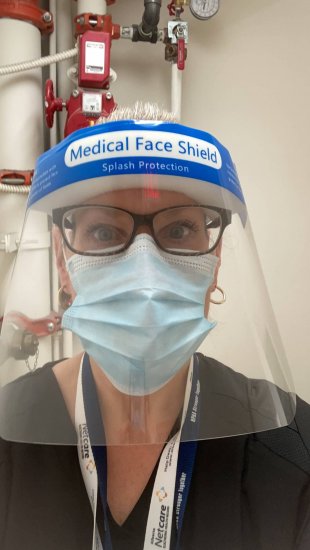Working as a nurse practitioner in assisted-living facilities during COVID-19
At the beginning of December, there was an emergent call in Alberta for available nurse practitioners to support continuing-care and assisted-living facilities with COVID-19 outbreaks.

The assistance of nurse practitioners was requested in an attempt to manage individuals’ symptoms onsite and avoid emergency department use and potential hospitalization—especially since the hospitals were (and continue to be) very full. Some nurse practitioners stopped their regular work and were deployed to the continuing-care homes with the highest number of cases to help manage patients.
In December, Athabasca University (AU) associate professor Dr. Jennifer Knopp-Sihota answered the call and was sent to an assisted-living facility in Edmonton.
Knopp-Sihota’s research focuses on improving the quality of care for older adults. She focuses mainly on frailty in older adults living in nursing homes and is currently researching ways to improve their clinical care. Through this experience, she has been able to make many observations that has helped inform her research further and has opened her eyes—as a clinician and a researcher.
“The big ‘aha’ moment for me was the realization that I have not had much experience in assisted living. I always assumed there was a lot of care and structure to these facilities. My eyes have been opened to the fact that because long-term care is so structured and regulated, it is easier to get resources. In assisted living, there are residents with various needs, dispersed everywhere,” she said.
Facing challenges head-on
As someone whose research is specific to long-term care facilities, Knopp-Sihota said the experience has opened her eyes to the many differences between long-term care facilities—specifically nursing homes—and assisted-living facilities.
She emphasized the biggest difference between the two is that in long-term care facilities, it’s more hospital-like—the residents usually have very high needs, and there is much more staff on site. In assisted-living facilities, it is more home-like, and residents have more independence.
When COVID strikes in an assisted-living facility that has less support to begin with, this makes it much more challenging to care for older adults who suddenly become ill and need extra assistance that they didn’t need previously.
Because of this, Knopp-Sihota emphasized that the role of the nurse practitioners sent to these facilities shifted drastically from their regular duties. Managing COVID-19 symptoms was the main concern and they were no longer tending to their regular patients and their chronic care needs.
“For the NP team, we don’t know the residents very well. It is challenging to care for someone who you’ve never met before, especially when access to their medical information is limited. You’re trying to piece together the COVID-19 situation, but also their past situation, and many frail and elderly individuals have over 10 medications,” she said.
“Trying to figure out where the best place for the patients to be was one of the biggest decisions. With so much being disrupted, and families not visiting and bringing necessities, we were negotiating with service providers and trying our best to care for them safely while also getting them what they needed.”
– Dr. Jennifer Knopp-Sihota, associate professor at AU
Timeliness is key
Knopp-Sihota said the key to it all was timeliness. And while the entire situation was stressful for the healthcare workers striving to manage outbreaks and symptoms as well as possible, she said the experience has been very isolating and difficult for the residents too.
“Families were no longer able to visit, bring groceries, or medication. There was no entertainment or gatherings. These individuals were on their own and completely isolated from their usual cohort of friends, families, and activities. The only people you see are the ones in full PPE (personal protective equipment). And you can’t leave your room if you’re positive or have symptoms,” she said. “At least the workers can go home to their families.”
Informing her research
Knopp-Sihota’s current research project focuses on pain assessment and identifying pain in nursing home residents with dementia. The study is aimed to improve pain assessment in order to better manage pain and improve the overall quality of care.
“Assisted living needs a lot of people to focus on it. Once I complete my other projects, I hope to expand into looking at how we can expand that sector of care. It’s very un-studied but also, very high need. We need to explore how else can we help workers in these facilities improve the care for the older adults, now and in the future,” she said.
“I love when your clinical practice informs your research and guides it. Having first-hand knowledge gives you perspective on what the research actually needs.”
– Dr. Jennifer Knopp-Sihota